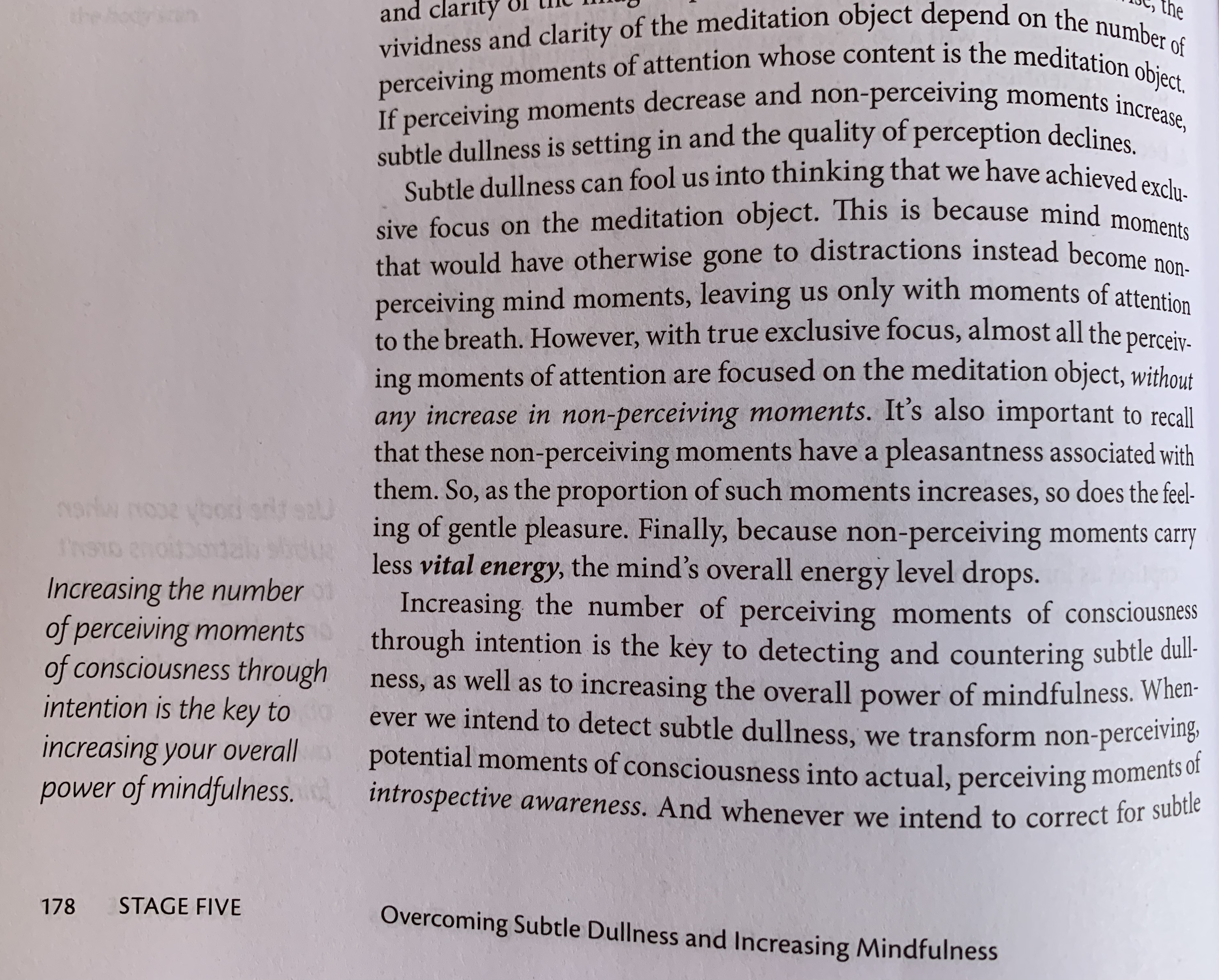
These are reflective notes on my experience of practicing Culadasa’s 10 stage meditation system. The notes in this post are from my tenth day of practice in the system. For an introduction to this project, see this page. Occasionally I will post-edit the journal. Any post-editing is [in square brackets like this].
The passage from the chapter on stage 5, above, describes an increase in “the feeling of gentle pleasure” as one progresses through the stages. This is in keeping with my experience of the system so far. I think it’s also true to say, as predicted, that my “overall energy level” during meditation has dropped somewhat, alongside the increase in pleasant contentedness.
The framework used to explain this experience is one of perceiving vs. non-perceiving ‘mind moments,’ an Abhidhamma concept.1 But the cause can only be a matter of conjecture. One could equally hypothesize that the increase in pleasant contentedness is caused by training positive regard for pleasant feelings and ignoring painful ones. Mind-moments are an experience induced by a particular kind of practice.
Samatha-vipassana trains time slicing, by noticing the minute detail of sensation in relation to time passing. This can be an extraordinary experience – as though our sense of time passing slows down so much that we are able to perceive change on a 1/10 second, then a 1/100 second basis, and so on. I haven’t had many of this kind of experience, but enough to know the phenomenon experientially and to understand how explaining it in terms of minuscule ‘mind-moments’ makes intuitive sense.
This intensely concentrated ‘time-reduction’ method associated with mindfulness is alien to Vajrayana. Rather than breaking time into smaller and smaller pieces, with minute attention to the detail of passing moments, Vajrayana leans into an expansive experience of continuity. Tantra, ‘rGyüd’ in Tibetan, means ‘continuity’. The Sutric path perfects the mind moment technique, possibly at the expense of a wider view. Vajrayana, particularly in the inner paths of Anuyoga and Dzogchen, emphasizes ‘all-seeing’ awareness, possibly at the expense of relevant detail. In Sutra, awareness is slowed to encourage conscientious response. In Tantra, awareness is expanded to encourage congruent activity. [This paragraph is rather general. See this comment and my reply for a more nuanced take.]
Day 10
30 min sit:
- Nothing much to say. Mostly thought free, focused on a larger body area than the tip of the nose, heartbeat seemed loud, some visual images arising occasionally.
Second sit, 1 hour:
- Quite mixed. Took about 5 - 10 mins to settle, longer than usual, maybe due to disrupted sleep overnight.
- Once thought free for a while, I was focusing on the sensation of the breath at the nose and intense pressure built up at a point in the left side of my nose. It became really intense, my face seemed skew, then parts of the left side of my body started spontaneously ‘unwinding’ with muscular twitches and spasms. Intuitively, it seemed like the pressure point in the nose was causing this.
- Moved several times between a ‘dark’ deeply concentrated, still, slow focus with awareness of sounds but very peaceful and a light, clear, open awareness, more centered around the breath, less ‘internal’, with pleasurable sensations around my crown and back of neck. It was a bit like the pleasurable sensations were making the quality of awareness lighter.
- Less concentrated in last 10 mins or so, aware of losing it a bit, some visual images arising, specifically random people’s faces.
- 1.For a ‘self’ to exist, there must be continuity. ‘Anatta’ (the realization of ‘no-self’), a central concept in Abhidhamma, relies on the notion of discontinuity. The practice methodology of perceiving smaller and smaller mind moments was invented as a practical means to achieve an experiential understanding of anatta.
